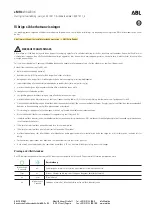•
For Li-Ion:
The voltage divider network for Li-Ion is very important. If the
battery voltage is scaled too low, the battery will not attain its
full capacity when charged, and if scaled too high, the
battery
may
become
damaged.
Never
exceed
the
recommended maximum voltage or current for a Li-Ion
battery!
The dimensioning is done in the following manner.
First calculate the maximum battery voltage for the specific
battery pack. See example below.
BatteryVoltage/Cell = 3.6V NumberOfCells = 2
→
Battery-
PackVoltage = 3.6x2 = 7.2V
MaximumBatteryVoltage/Cell = 4.1V
→
MaximumBattery-
Voltage = 4.1x2 = 8.2V
When the maximum battery voltage has been determined,
the voltage divider network has to be dimensioned using the
following formula:
The LM3647 has two different regulation voltages, which the
user can select. These are 2.675V (SEL3 tied to GND) and
2.740V (SEL3 tied to V
CC
). This selection pin can be used to
configure the charger to regulate for different input voltages
so that the charger can handle both 3.6V- and 3.7V-cells,
without changing the resistor values in the divider network.
SEL3 can also be used if there is problem in finding the right
values in the resistor network. The recommended tolerance
of the resistors are 0.1%, but 1% may be used with a
marginal loss of battery capacity by subtracting the tolerance
of the divider network from the maximum battery voltage.
•
Using
the
LM3647
without
current
feedback,
for
Ni-Cd/Ni-MH only (slow PWM mode):
This mode uses an external constant-current power-source,
which is switched on and off according to the charge-phase
of the LM3647. The frequency is approximately 0.1 Hz. The
advantage of this charge method is that operational
amplifiers and the current feedback circuitry are not needed,
which provides a low-cost solution. The dimensioning of the
voltage divider network is performed the same way. The
constant current source is dimensioned in the following
manner:
The LM3647 regulates the constant current source by
turning the transistor Q1 on and off.
When the transistor is off, the LM317T regulator feeds a
constant current to the battery (at V_OUT).
When the transistor is on, the output from the LM317 is
limited to 1.25V (which should be greater than the battery
voltage).
Charge Phase:
Duty Cycle:
Soft Start
10%
Fast Charge
100%
Topping Charge
10%
Maintenance Charge
5%
AN101315-7
AN-1
164
www.national.com
5


















